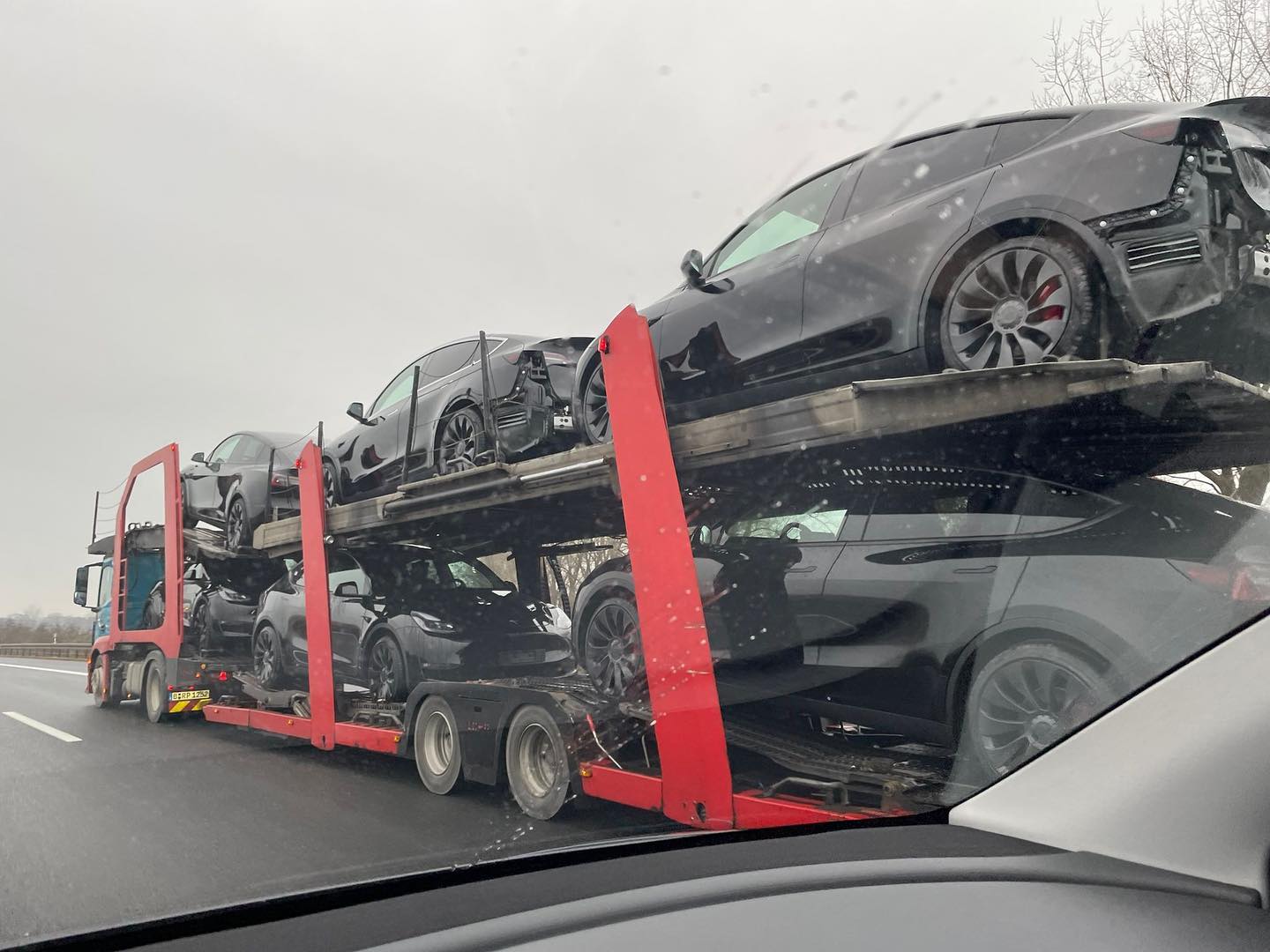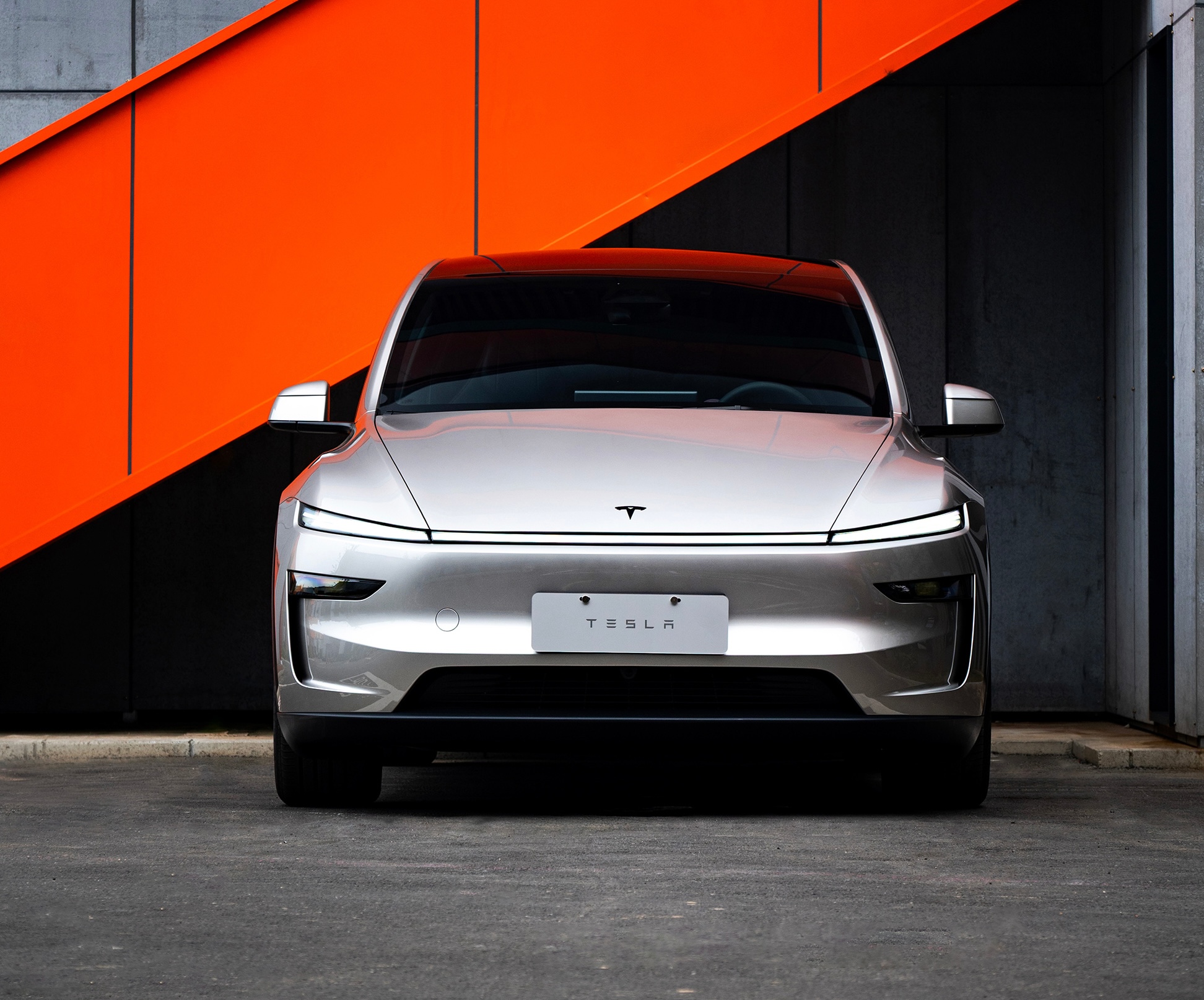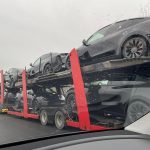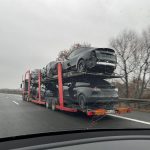

News
Tesla Model Y Performance trims spotted leaving Gigafactory Berlin
Tesla Model Y Performance variants were spotted on vehicle haulers in Germany, leaving the soon-to-be-approved production facility the automaker plans to open near Berlin in early 2022.
Images of Model Y Performance configurations were spotted by Steve and Julian Igembb on Facebook and shared by user @TeslaAdri on Twitter. The photographs show six Model Y Performance vehicles on haulers, likely being transported to a nearby facility for crash testing, emissions assessments, and range rating research as the vehicle will eventually be produced at the plant and delivered to customers.
- Credit: Steve&Julian Igembb | Facebook
- Credit: Steve&Julian Igembb | Facebook
The Performance trim can be recognized in several ways: red brake calipers or a red line under the “Dual Motor” badge, located on the vehicle’s trunk.
The Model Y is Tesla’s most recently released vehicle, being delivered for the first time in March 2020. Since then, the vehicle has become Tesla’s best-seller, overtaking the Model 3 sedan. It has taken priority at Tesla’s first European production facility and will be produced there initially, with other vehicles to follow after the all-electric crossover has been fully ramped at the plant.
Prior to the Model 3 Performance being built at Tesla’s Gigafactory Shanghai plant in China, images of that vehicle were also spotted being transported to an unknown location on vehicle haulers.
Tesla Model 3 Performance on car carriers spotted departing Giga Shanghai
Gigafactory Berlin was expected to begin production before the end of 2021. However, various bottlenecks in regulatory processes have pushed Tesla’s initial production at Giga Berlin to early 2022. Tesla has sparred regularly with local environmental groups, who have raised concerns over groundwater and other potentially hazardous elements, like a storage tank, at the site. Recent holdups have been related to a hearing related to water pumping at a nearby facility, as the Eggersdorf waterworks facility approved increased water pumping rates for the facility without necessary testing. The Administrative Court in Frankfurt confirmed that the hearing was supposed to take place on December 6. However, it was postponed and has still not taken place.
As a result, various sources close to the mater expected the factory to not begin production by the end of 2021. It now seems that, with less than two days left in the year, Tesla will start production in early 2022.
I’d love to hear from you! If you have any comments, concerns, or questions, please email me at joey@teslarati.com. You can also reach me on Twitter @KlenderJoey, or if you have news tips, you can email us at tips@teslarati.com.

Investor's Corner
Tesla gets bold Robotaxi prediction from Wall Street firm
Last week, Andrew Percoco took over Tesla analysis for Morgan Stanley from Adam Jonas, who covered the stock for years. Percoco seems to be less optimistic and bullish on Tesla shares, while still being fair and balanced in his analysis.

Tesla (NASDAQ: TSLA) received a bold Robotaxi prediction from Morgan Stanley, which anticipates a dramatic increase in the size of the company’s autonomous ride-hailing suite in the coming years.
Last week, Andrew Percoco took over Tesla analysis for Morgan Stanley from Adam Jonas, who covered the stock for years. Percoco seems to be less optimistic and bullish on Tesla shares, while still being fair and balanced in his analysis.
Percoco dug into the Robotaxi fleet and its expansion in the coming years in his latest note, released on Tuesday. The firm expects Tesla to increase the Robotaxi fleet size to 1,000 vehicles in 2026. However, that’s small-scale compared to what they expect from Tesla in a decade.
Tesla expands Robotaxi app access once again, this time on a global scale
By 2035, Morgan Stanley believes there will be one million Robotaxis on the road across multiple cities, a major jump and a considerable fleet size. We assume this means the fleet of vehicles Tesla will operate internally, and not including passenger-owned vehicles that could be added through software updates.
He also listed three specific catalysts that investors should pay attention to, as these will represent the company being on track to achieve its Robotaxi dreams:
- Opening Robotaxi to the public without a Safety Monitor. Timing is unclear, but it appears that Tesla is getting closer by the day.
- Improvement in safety metrics without the Safety Monitor. Tesla’s ability to improve its safety metrics as it scales miles driven without the Safety Monitor is imperative as it looks to scale in new states and cities in 2026.
- Cybercab start of production, targeted for April 2026. Tesla’s Cybercab is a purpose-built vehicle (no steering wheel or pedals, only two seats) that is expected to be produced through its state-of-the-art unboxed manufacturing process, offering further cost reductions and thus accelerating adoption over time.
Robotaxi stands to be one of Tesla’s most significant revenue contributors, especially as the company plans to continue expanding its ride-hailing service across the world in the coming years.
Its current deployment strategy is controlled and conservative to avoid any drastic and potentially program-ruining incidents.
So far, the program, which is active in Austin and the California Bay Area, has been widely successful.
News
Tesla Model Y L is gaining momentum in China’s premium segment
This suggests that the addition of the Model Y L to Tesla China’s lineup will not result in a case of cannibalization, but a possible case of “premiumization” instead.

Tesla’s domestic sales in China held steady in November with around 73,000 units delivered, but a closer look at the Model Y L’s numbers hints at an emerging shift towards pricier variants that could very well be boosting average selling prices and margins.
This suggests that the addition of the Model Y L to Tesla China’s lineup will not result in a case of cannibalization, but a possible case of “premiumization” instead.
Tesla China’s November domestic numbers
Data from the a Passenger Car Association (CPCA) indicated that Tesla China saw domestic deliveries of about 73,000 vehicles in November 2025. This number included 34,000 standard Model Y units, 26,000 Model 3 units, and 13,000 Model Y L units, as per industry watchers.
This means that the Model Y L accounted for roughly 27% of Tesla China’s total Model Y sales, despite the variant carrying a ~28% premium over the base RWD Model Y that is estimated to have dominated last year’s mix.
As per industry watcher @TSLAFanMtl, this suggests that Tesla China’s sales have moved towards more premium variants this year. Thus, direct year-over-year sales comparisons might miss the bigger picture. This is true even for the regular Model Y, as another premium trim, the Long Range RWD variant, was also added to the lineup this 2025.
November 2025 momentum
While Tesla China’s overall sales this year have seen challenges, the Model Y and Model 3 have remained strong sellers in the country. This is especially impressive as the Model Y and Model 3 are premium-priced vehicles, and they compete in the world’s most competitive electric vehicle market. Tesla China is also yet to roll out the latest capabilities of FSD in China, which means that its vehicles in the country could not tap into their latest capabilities yet.
Aggregated results from November suggest that the Tesla Model Y took the crown as China’s #1 best-selling SUV during the month, with roughly 34,000 deliveries. With the Model Y L, this number is even higher. The Tesla Model 3 also had a stellar month, seeing 25,700 deliveries during November 2025.
Cybertruck
Tesla Cybertruck earns IIHS Top Safety Pick+ award
To commemorate the accolade, the official Cybertruck account celebrated the milestone on X.

The Tesla Cybertruck has achieved the Insurance Institute for Highway Safety’s (IIHS) highest honor, earning a Top Safety Pick+ rating for 2025 models built after April 2025.
The full-size electric pickup truck’s safety rating is partly due to the vehicle’s strong performance in updated crash tests, superior front crash prevention, and effective headlights, among other factors. To commemorate the accolade, the official Cybertruck account celebrated the milestone on X.
Cybertruck’s IIHS rating
As per the IIHS, beginning with 2025 Cybertruck models built after April 2025, changes were made to the front underbody structure and footwell to improve occupant safety in driver-side and passenger-side small overlap front crashes. The moderate overlap front test earned a good rating, and the updated side impact test also received stellar marks.
The Cybertruck’s front crash prevention earned a good rating in pedestrian scenarios, with the standard Collision Avoidance Assist avoiding collisions in day and night tests across child, adult crossing, and parallel paths. Headlights with high-beam assist compensated for limitations, contributing to the top award.
Safest and most autonomous pickup
The Cybertruck is one of only two full-size pickups to receive the IIHS’ Top Safety Pick + rating. It is also the only one equipped with advanced self-driving features via Tesla’s Full Self-Driving (Supervised) system. Thanks to FSD, the Cybertruck can navigate inner city streets and highways on its own with minimal supervision, adding a layer of safety beyond passive crash protection.
Community reactions poured in, with users praising the vehicle’s safety rating amidst skepticism from critics. Tesla itself highlighted this by starting its X post with a short clip of a Cybertruck critic who predicted that the vehicle will likely not pass safety tests. The only question now is, of course, if the vehicle’s Top Safety Pick+ rating from the IIHS will help the Cybertruck improve its sales.










